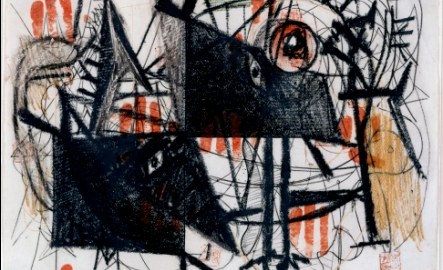With Friends Like These: How Isamu Noguchi Became an Artist

If the The Noguchi Museum’s 25th anniversary exhibition were an episode of Friends, it would be titled “The One Where Isamu Became an Artist.” On Becoming an Artist: Isamu Noguchi and his Contemporaries, 1922-1960, which runs through April 24, 2011, demonstrates just how Isamu Noguchi navigated through the worlds of sculpture, painting, dance, theater, and even architecture and design with a little help from his friends. Borrowing bits from different means of expression, Noguchi added them together into the greater sum of his sculpture. With friends like Arshile Gorky, Constantin Brancusi, Frida Kahlo, Martha Graham, and Louis Kahn, Noguchi became an artistic force transcending traditional boundaries.
Along with the original works of art, personal letters, fragments of interviews, photographs, and other mementos tell the story of Noguchi and his multiple circles of friends across two continents. “These friends, peers, mentors, lovers, father figures, teachers and facilitators,” writes Amy Wolf in the introduction to the exhibition catalogue, “influenced [Noguchi’s] artistic practice and ideas and fostered the evolution of his personal and artistic identity.” Despite this close proximity to powerful personalities, Noguchi never lost his individuality. “From all Noguchi sought the path ahead,” Wolf writes, “obtaining from a few lifelong inspiration and from others immediate opportunities.” This exhibition follows Noguchi’s path to self-actualization over the years from the Roaring Twenties to the Cold War.
Noguchi’s quest to become the Kevin Bacon of modern art began with in the studio of Gutzon Borglum of Mount Rushmore fame. Working with Borglum exposed Noguchi to the art of Auguste Rodin by osmosis, which brought that lingering Romanticism to Noguchi’s sculpture and began Noguchi’s indirect, “hands on” art history education. “[A] lot of people study art history,” Noguchi explained. “I never had any. So my way of looking at things is without any preparation and without an knowledge really… my educational process has always been sort of backward…I just know the idea, so to speak… I know it by looking rather than through any knowledge.” Noguchi knew art by looking, and living, with other artists such as Borglum.
Constantin Brancusi served as the second major stop in Noguchi’s lived art education. On his way to India on a Guggenheim Fellowship, Noguchi stopped over in Paris, and never made it to India. While there, Noguchi drank in Brancusi’s style as deeply as he drank in the Parisian lifestyle. Calling it “the opportunity of a life-time,” Noguchi “assiduously studied [Brancusi’s] method of handling sculptural material,” he wrote back to the Guggenheim people, “a method so entirely reasonable and free from tricks that I feel convinced that it must be much the same as that practiced by the ancient Greeks.” When Brancusi’s power threatened to overpower his individuality, however, Noguchi fled. “Not that I hated Brancusi,” Noguchi explained years later, “I didn’t hate him, but I felt obliged to be free of him.”
Returning to America, Noguchi sought that Paris café feel in New York City. “Paris’s cafes, academies and art studios provided his first sense of a home among peers whose passions and interests he shared while at the same time contrasting with his own uneasy feelings about his place in society,” Wolf explains. “These friendships provided the foundation for his sense of community when he returned to New York.” And by New York, Noguchi meant Greenwich Village.
A handy map of artist’s studios in Greenwich Village from 1920 to 1940 shows just how cozy arrangements were for Noguchi and his friends. Arshile Gorky, Onorio Ruotolo, Stuart Davis, and many others lived and worked just blocks from one another. When Hitler’s soldiers invaded Poland on September 1, 1939, Noguchi listened to the news on the radio with Gorky and De Hirsh Margulies. The three artists seized the moment to create a series of works (including the one shown above) to illustrate their feelings about the impending world crisis. Art feels like such an individual enterprise so often that these collaborations seem almost fantastical, but Noguchi’s personal charm and grace allowed him to coexist with other artists at a level that made such cooperation possible.
Beyond Noguchi’s affinity for other artists—both painters and sculptors—what really stands out is his ability to find inspiration from the medium of dance. Martha Graham, Merce Cunningham, Michio Ito, Ruth Page, Yuriko, Erick Hawkins, George Balanchine, and others helped Noguchi bring a sense of motion to his still sculpture beyond even that inspired by Brancusi. Similarly, work with architects and designers such as Louis Kahn and Richard Neutra helped Noguchi envision sculpture as an environment in which the viewer could exist, especially in the gardens Noguchi began to design and the mass-produced furniture he developed to bring his art into homes of those who normally didn’t live with art.
“I shift,” Noguchi said in an interview in response to a question about his movements through media and different circles of influence. “You know, you feel lonely after a while and you want to have contact. I work with architects, dancers, and what not, partly for the contact, partly for the experience of working more in space.” In making important contacts in the art world, Noguchi made contact with ideas and spirits that shaped his own ideas and spirit. If the old adage that you can judge someone by their friends is true, then this exhibition on Noguchi’s associations is the perfect judgment of his achievement. On Becoming an Artist: Isamu Noguchi and his Contemporaries, 1922-1960 proves that sometimes it does take a village—a global village, in this case—to raise an artist from simple beginnings, but that it takes a special person, such as Isamu Noguchi, to find and learn from the right people.
[Image: Isamu Noguchi, Arshile Gorky, De Hirsh Margulies. Hitler Invades Poland, September 1, 1939. Crayon and sealing ink on paper, 17 1/2 x 22 7/8 in. © 2010 The Isamu Noguchi Foundation and Garden Museum, New York/Artists Rights Society (ARS), New York. © 2010 The Arshile Gorky Foundation/Artists Rights Society (ARS), New York; Courtesy Gallery Gertrude Stein, New York.]
[Many thanks to the The Noguchi Museum for providing me with the image above and a review copy of the catalogue to the exhibition On Becoming an Artist: Isamu Noguchi and his Contemporaries, 1922-1960, which runs through April 24, 2011.]





